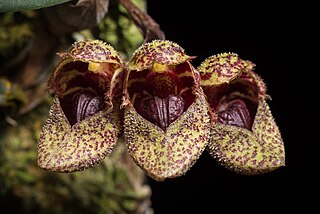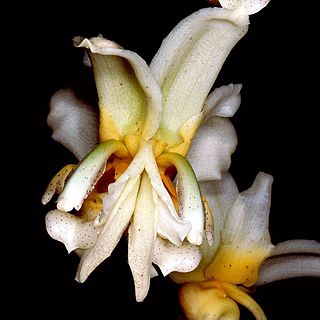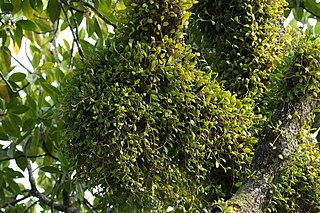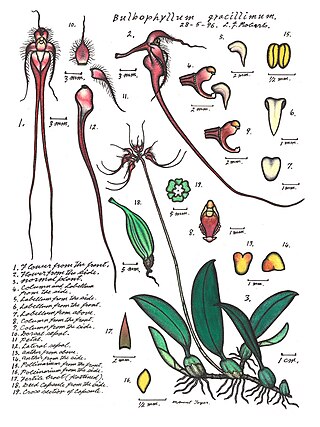
Bulbophyllum is a genus of mostly epiphytic and lithophytic orchids in the family Orchidaceae. It is the largest genus in the orchid family and one of the largest genera of flowering plants with more than 2,000 species, exceeded in number only by Astragalus. These orchids are found in diverse habitats throughout most of the warmer parts of the world including Africa, southern Asia, Latin America, the West Indies, and various islands in the Indian and Pacific Oceans. Orchids in this genus have thread-like or fibrous roots that creep over the surface of trees or rocks or hang from branches. The stem is divided into a rhizome and a pseudobulb, a feature that distinguished this genus from Dendrobium. There is usually only a single leaf at the top of the pseudobulb and from one to many flowers are arranged along an unbranched flowering stem that arises from the base of the pseudobulb. Several attempts have been made to separate Bulbophyllum into smaller genera, but most have not been accepted by the World Checklist of Selected Plant Families.

Spiranthes spiralis, commonly known as autumn lady's-tresses, is an orchid that grows in Europe and adjacent North Africa and Asia. It is a small grey-green plant. It forms a rosette of four to five pointed, sessile, ovate leaves about 3 cm (1.2 in) in length. In late summer an unbranched stem of about 10–15 cm (3.9–5.9 in) tall is produced with approximately four sheath-shaped leaves. The white flowers are about 5 mm (0.20 in) long and have a green spot on the lower lip. They are arranged in a helix around the upper half of the stalk. The species is listed in Appendix II of CITES as a species that is not currently threatened with extinction but that may become so. Autumn lady's-tresses are legally protected in Belgium and the Netherlands, and in some regions of France.

Bulbophyllum frostii, commonly known as Frost's bulbophyllum or Dutchman's shoes is a species of orchid, In the wild it grows as an epiphyte, inhabiting evergreen seasonal lowland rainforests in Vietnam and more rarely in Thailand, including the Malay peninsula. It was more recently reported growing in the Yunnan province of China during a series of botanical surveys between 2017 and 2020. This plant is usually found at elevations of around 1500m above sea level.

Stanhopea pseudoradiosa is a species of orchid endemic to southwestern Mexico. It is found in the provinces of Oaxaca, Colima and Guerrero, in western slopes in oak, oak-pine and tropical subdeciduous forests at elevations of 750 to 1300 meters.

Bulbophyllum annandalei or Annandale's Bulbophyllum is a species of orchid in the genus Bulbophyllum in section Cirrhopetalum.

Bulbophyllum clandestinum is a species of orchid in the genus Bulbophyllum. This orchid grows long hanging rhizomes from which it produces tiny pseudobulbs that each bear one leaf. Flowers are born on each node, they are 3–5 cm in length and are a creamy colour. It is native to Borneo, Laos, Malaysia, Myanmar, Thailand, the Philippines, and Vietnam.

Bulbophyllum cruciatum is a species of orchid in the genus Bulbophyllum found in Papua, Papua New Guinea, Seram Island, and Maluku Islands.

Bulbophyllum exiguum, commonly known as the tiny strand orchid, is a species of epiphytic or lithophytic orchid that is endemic to eastern Australia. It has small, roughly spherical pseudobulbs each with a single leaf and up to three small creamy white to yellow flowers emerging from the base of the pseudobulb. This orchid grows in rainforest and dry forest where it often covers the branches of trees or rocks on which it grows.

Bulbophyllum gracillimum, commonly known as the wispy umbrella orchid, is a species of epiphytic orchid. It has a creeping rhizome, widely spaced, olive green pseudobulbs, each with a single thick, leathery, fleshy leaf and between six and ten purplish red flowers spreading in a semicircular umbel. The flowers have distinctive long, thread-like tails on the lateral sepals. It has a wide distribution and is found in New Guinea, New Caledonia, Indonesia, Malaysia and part of tropical North Queensland.
Bulbophyllum leucorhodum is a species of orchid in the genus Bulbophyllum. It was described by Schltr. in 1913. The orchid is a small-sized epiphytic orchid native to New Guinea, thrives in range forests at elevations around 1000 meters. Its close-set, conical-cylindrical pseudobulbs support a single, apical, erect, ligulate leaf that is obtuse at the apex and narrows towards the base, forming a subpetiolate structure. This warm to cool-growing orchid blooms in the later fall and winter, producing a single flower on an erect, very short, single-flowered inflorescence.

Bulbophyllum phalaenopsis is a species of orchid in the genus Bulbophyllum.

Bulbophyllum plumatum is a species of orchid in the genus Bulbophyllum.

Bulbophyllum retusiusculum is a species of orchid in the genus Bulbophyllum.

Bulbophyllum rosemarianum is a species of orchid in the genus Bulbophyllum.
Bulbophyllum sphaericum is a species of orchid in the genus Bulbophyllum. It is found in Sichuan and Yunnan, providence of China. The Bulbophyllum sphaericum is a warm to cool growing epiphyte with a creeping, branching rhizome with .4" [1 cm] between each globose pseudobulb carrying a single, apical, thickly leathery, elliptic-oblong, abaxially purplish red, adaxially pale green, margin slightly recurved, retuse apically, sessile base leaf that blooms in the summer on an erect, basal from the pseudobulb, much longer than the leaf, 4 to 5 flowered inflorescence holding the flowers in an apical umbel.

Bulbophyllum wangkaense is a species of orchid in the genus Bulbophyllum.
Bulbophyllum windsorense, commonly known as the thread-tipped rope orchid, is a species of epiphytic orchid that has small pseudobulbs partly hidden by brown, papery bracts. Each pseudobulb has a single fleshy, dark green, grooved leaf and one or two cream-coloured or greenish flowers. It mainly grows near the breezy tops of trees, especially Callitris macleayana trees and is endemic to tropical North Queensland.
Bulbophyllum nocturnum is a species of epiphytic orchid that grows in New Britain. It was described in 2011, and is the first species of orchid known to consistently flower during the night, and close its flowers during the day.

Hakea flabellifolia, commonly known as the fan-leaved hakea or wedge hakea, is a shrub in the family Proteaceae. It is endemic to an area along the west coast in the Mid West and Wheatbelt regions of Western Australia.

Bulbophyllum maxillare, commonly known as the red horntail orchid, is a species of epiphytic orchid with tapered grooved, dark green to yellowish pseudobulbs, each with a single large, thin leaf and a single reddish flower with yellow or white edges. The lateral sepals are much larger than the dorsal sepal which in turn is much larger than the petals. It grows on the lower branches of rainforest trees in India, New Guinea and tropical North Queensland.
















